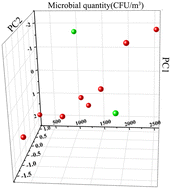A microbial quantity monitoring model based on 3D fluorescence data of the cucumber storeroom gas and its use in providing auxiliary early spoilage warning
Abstract
A real-time model for monitoring the microbial quantity based on the microbial intrinsic fluorescence information of cucumber storeroom gas was established. Firstly, 3D fluorescence data of the storeroom gas were collected on different storage days. Secondly, the number of components of a parallel factor model was determined to be 3 using the core consistency diagnostic. Thirdly, parallel factor analysis was used to decompose the fluorescence data to obtain the excitation spectra, emission spectra and concentration scores of 3 components. The positions of the fluorescence peaks were consistent with the fingerprints of tryptophan-like, tyrosine-like and phenylalanine-like substances in the characteristic spectrum of each component. And then the prediction model was constructed by fitting the concentration scores of the 3 components with the microbial quantity, and the coefficient of determination was 98.27%, and the cross-validation determination coefficient could reach 91.97%. Finally, after integrating the predicted value of the microbial quantity and the total chromatism of the cucumber pericarp during cucumber storage, the spoilage date was determined to be the 7th day by K-means clustering. The results show that the monitoring model constructed through distinguishing the fluorescence data of airborne microorganisms can effectively monitor the spoilage process.

- This article is part of the themed collection: Analyst HOT Articles 2022


 Please wait while we load your content...
Please wait while we load your content...